I grew up in a society where collective will was at the forefront and it…
US labour market slower but relative to what?
In last month’s US labour market briefing – US labour market – stability abounds although, worryingly, real wage gains have evaporated (October 9, 2023) – I noted that while there was no major slowdown signalled, the real wage gains made in previous months had evaporated. I wasn’t sure whether that was a sign that a tipping point had been reached or was near. Last Friday (November 3, 2023), the US Bureau of Labor Statistics (BLS) released their latest labour market data – Employment Situation Summary – October 2023 – which showed payroll employment rising by just 150,000, a significant dip in the previous month’s increase. The unemployment rate also continued to creep up to 3.9 per cent (from 3.8 per cent). While some might interpret this as a weakening trend, the question should be asked about the appropriate benchmark that we should be using. One could easily conclude that the aggregates are returning to pre-pandemic levels after all the pandemic noise. The alternative view is that there is a slowdown occurring. We will have to wait another month or so to distinguish between these two conjectures. After a few months of real wage gains, we are now observing nominal wages growth trailing the moderating inflation rate.
Overview for October 2023 (seasonally adjusted):
- Payroll employment increased by 150,000 (down from 336,000 last month).
- Total labour force survey employment fell by 348 thousand net (0.22 per cent).
- The labour force fell 201 thousand net (0.12 per cent) – these changes could be due to sampling variability.
- The participation rate fell 0.1 point at 62.7 per cent.
- Total measured unemployment rose by 146 thousand to 6,506 thousand and would have been larger had the participation rate not fallen.
- The official unemployment rate rose 0.1 point to 3.9 per cent.
- The broad labour underutilisation measure (U6) rose 0.2 points to 7.2 per cent – due to both the rise in official unemployment and the rise in underemployment (in equal measure).
- The employment-population ratio fell 0.2 points to 60.2 per cent (still well below the June 2020 peak of 61.2).
For those who are confused about the difference between the payroll (establishment) data and the household survey data you should read this blog post – US labour market is in a deplorable state – where I explain the differences in detail.
Some months the difference is small, while other months, the difference is larger.
Payroll employment trends
The BLS noted that:
Total nonfarm payroll employment increased by 150,000 in October, below the average monthly gainof 258,000 over the prior 12 months …
Health care added 58,000 jobs in October, in line with the average monthly gain of 53,000 over the prior 12 months …
Employment in government increased by 51,000 in October and has returned to its pre-pandemic February 2020 level. Monthly job growth in government had averaged 50,000 in the prior 12 months …
Social assistance added 19,000 jobs in October, compared with the average monthly gain of 23,000 over the prior 12 months …
… construction employment continued to trend up (+23,000), about in line with the average monthly gain of 18,000 over the prior 12 months …
Employment in manufacturing decreased by 35,000 in October …
In October, employment in leisure and hospitality changed little (+19,000). The industry had added an average of 52,000 jobs per month over the prior 12 months.
Employment in professional and business services was little changed in October (+15,000) and has shown little net change since May …
In October, employment in transportation and warehousing was little changed (-12,000) and has shown little net change over the year …
Information employment changed little in October (-9,000) …
Over the month, employment showed little change in other major industries …
In summary, monthly payroll employment growth appears to be returning to the pre-pandemic levels, which could be interpreted as a slowdown, but the latter assessment is only relative to the elevated growth rates following the pandemic.
The first graph shows the monthly change in payroll employment (in thousands, expressed as a 3-month moving average to take out the monthly noise). The red lines are the annual averages. Observations between March 2020 and March 2022 were excluded as outliers.
The average line (which does not exclude the outliers) allows you to see the extent of the slowdown over the first two years of the Covid outbreak.
The next graph shows the same data in a different way – in this case the graph shows the average net monthly change in payroll employment (actual) for the calendar years from 2005 to 2023.
The red marker on the column is the current month’s result.
Average monthly change – 2019-2023 (000s)
| Year | Average Monthly Employment Change (000s) |
| 2019 | 163 |
| 2020 | -774 |
| 2021 | 606 |
| 2022 | 399 |
| 2023 (so far) | 239 |
Labour Force Survey data – employment growth negative
The seasonally-adjusted data for October 2023 reveals:
1. Total labour force survey employment ell by 348 thousand net (0.22 per cent) – a fairly significant slowdown signalled.
2. The labour force fell by 201 thousand net (0.12 per cent) – reversing the large rise last month.
3.The participation rate fell by 0.1 point 62.7 per cent.
4. As a result (in accounting terms), total measured unemployment rose by 146 thousand to 6,506 thousand – which would have been worse if the participation rate had not have fallen.
5. The official unemployment rate rose 0.1 point to 3.9 per cent.
While I suspect some of this variation is sampling induced, I also think there is a slowdown occurring in the US labour market.
The following graph shows the monthly employment growth since January 2008 and excludes the extreme observations (outliers) between March 2020 and March 2022, which distort the current period relative to the pre-pandemic period.
The Employment-Population ratio is a good measure of the strength of the labour market because the movements are relatively unambiguous because the denominator population is not particularly sensitive to the cycle (unlike the labour force).
The following graph shows the US Employment-Population from January 1950 to October 2023.
In September 2023, the ratio was unchanged at 60.2 per cent down 0.2 points.
The peak level in September 2020 before the pandemic was 61.1 per cent.
Unemployment and underutilisation trends
The BLS note that:
Both the unemployment rate, at 3.9 percent, and the number of unemployed persons, at 6.5 million, changed little in October. However, since their recent lows in April, these measures are up by 0.5 percentage point and 849,000, respectively …
In October, the number of long-term unemployed (those jobless for 27 weeks or more) was little changed at 1.3 million. The long-term unemployed accounted for 19.8 percent of all unemployed persons …
The number of persons employed part time for economic reasons, at 4.3 million, changed little in October. These individuals, who would have preferred full-time employment, were working part time because their hours had been reduced or they were unable to find full-time jobs.
While the official unemployment rate has ‘inched’ up over the last several months, a lot of the variation has been due to fluctuations in the participation rate, some of which is probably just sampling variation.
The first graph shows the official unemployment rate since January 1994.
The official unemployment rate is a narrow measure of labour wastage, which means that a strict comparison with the 1960s, for example, in terms of how tight the labour market, has to take into account broader measures of labour underutilisation.
The next graph shows the BLS measure U6, which is defined as:
Total unemployed, plus all marginally attached workers plus total employed part time for economic reasons, as a percent of all civilian labor force plus all marginally attached workers.
It is thus the broadest quantitative measure of labour underutilisation that the BLS publish.
Pre-COVID, U6 was at 6.8 per cent (January 2019).
In September 2023 the U6 measure was 7.2 per cent up 0.2 points – in equal measure due to the rise in underemployment and official unemployment.
What about wages growth in the US?
The BLS reported that:
In October, average hourly earnings for all employees on private nonfarm payrolls rose by 7 cents, or 0.2 percent, to $34.00. Over the past 12 months, average hourly earnings have increased by 4.1 percent. In October, average hourly earnings of private-sector production and nonsupervisory employees rose by 10 cents, or 0.3 percent, to $29.19.
So still no hint of a wages breakout emerging!
And more to the point real wages are continuing to fall.
The latest – BLS Real Earnings Summary – September 2023 (published October 12, 2023) – tells us that:
Real average hourly earnings for all employees decreased 0.2 percent from August to September, seasonally adjusted … This result stems from an increase of 0.2 percent in average hourly earnings combined with an increase of 0.4 percent in the Consumer Price Index for All Urban Consumers (CPI-U).
Real average weekly earnings decreased 0.2 percent over the month due to the change in real average hourly earnings combined with no change in the average workweek.
Real average hourly earnings increased 0.5 percent, seasonally adjusted, from September 2022 to September 2023. The change in real average hourly earnings combined with a decrease of 0.6 percent in the average workweek resulted in a 0.1-percent decrease in real average weekly earnings over this period.
So even with moderating inflation, nominal wages growth is so low that the real wage gains of the lst few months have mostly evaporated.
The following table shows the movements in nominal Average Hourly Earnings (AHE) by sector and the inflation-adjusted AHE by sector for September 2023 (note we are adjusting using the August CPI – the latest available).
The nominal wages slowdown has impacted on most sectors with 8 out of 19 sectors recording monthly contractions in real wages.
The following graph shows annual growth in real average hourly earnings from 2008 to September 2023.
The other indicator that tells us whether the labour market is turning in favour of workers is the quit rate.
The most recent BLS data – Job Openings and Labor Turnover Summary (released October 3, 2023) – shows that:
The number of job openings changed little at 9.6 million on the last business day of September … Over the month, the number of hires and total separations changed little at 5.9 million and 5.5 million, respectively. Within separations, quits (3.7 million) and layoffs and discharges (1.5 million) changed little. …
In August, the number of quits changed little at 3.7 million and the rate was 2.3 percent for the 3rd consecutive month.
So in August 2023, the dynamics of the US labour market were pretty stable.
Conclusion
The latest monthly data shows payroll employment rising by just 150,000, a significant dip in the previous month’s increase.
The unemployment rate also continued to creep up to 3.9 per cent (from 3.8 per cent).
While some might interpret this as a weakening trend, the question should be asked about the appropriate benchmark that we should be using.
One could easily conclude that the aggregates are returning to pre-pandemic levels after all the pandemic noise.
The alternative view is that there is a slowdown occurring.
We will have to wait another month or so to distinguish between these two conjectures.
After a few months of real wage gains, we are now observing nominal wages growth trailing the moderating inflation rate.
That is enough for today!
(c) Copyright 2023 William Mitchell. All Rights Reserved.
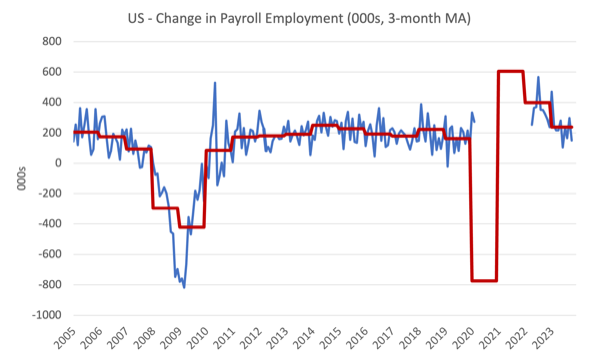

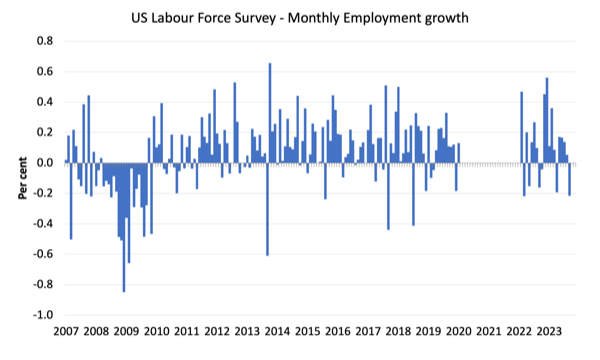
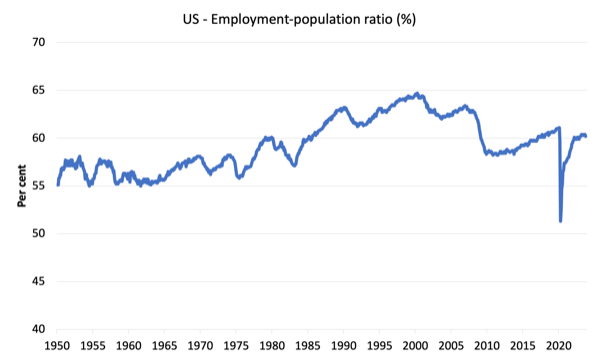
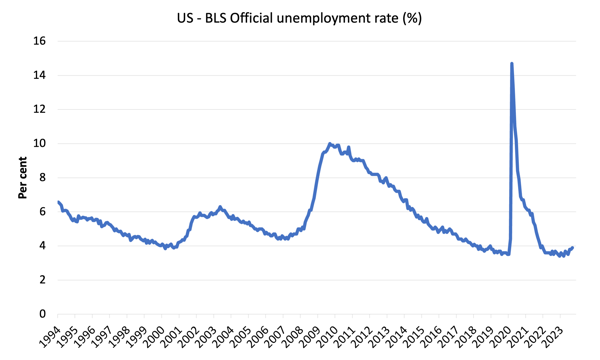
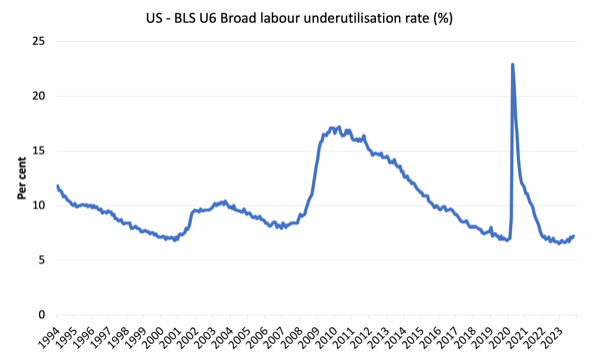
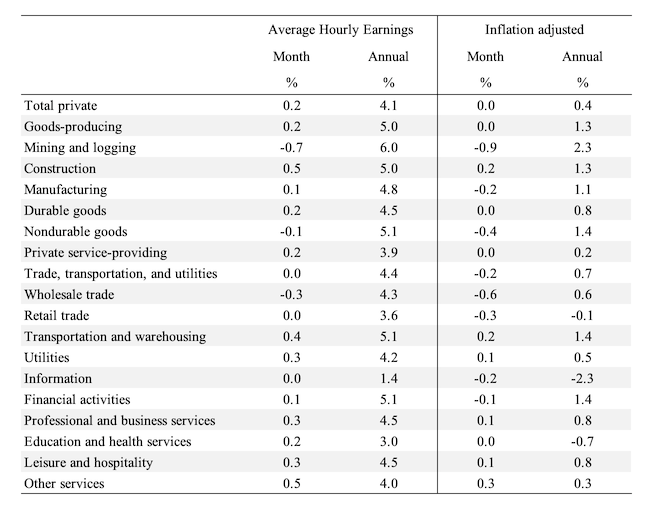
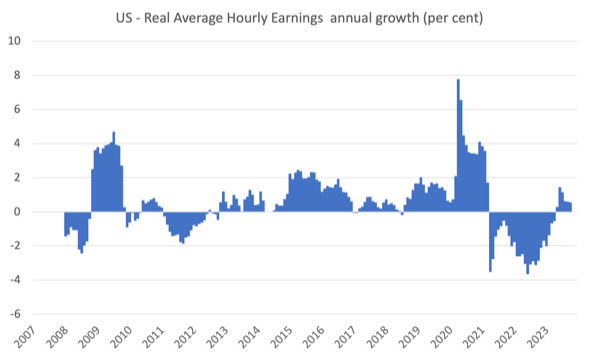
Average weekly hours are down pretty sharply over the last couple years (both manufacturing and services).
Services hours appear to be headed back to pre-pandemic levels. Manufacturing hours never recovered to pre-pandemic levels (automation) and currently hover around pre-GFC levels.
The employment contraction, so far, has been in temp jobs and hours.